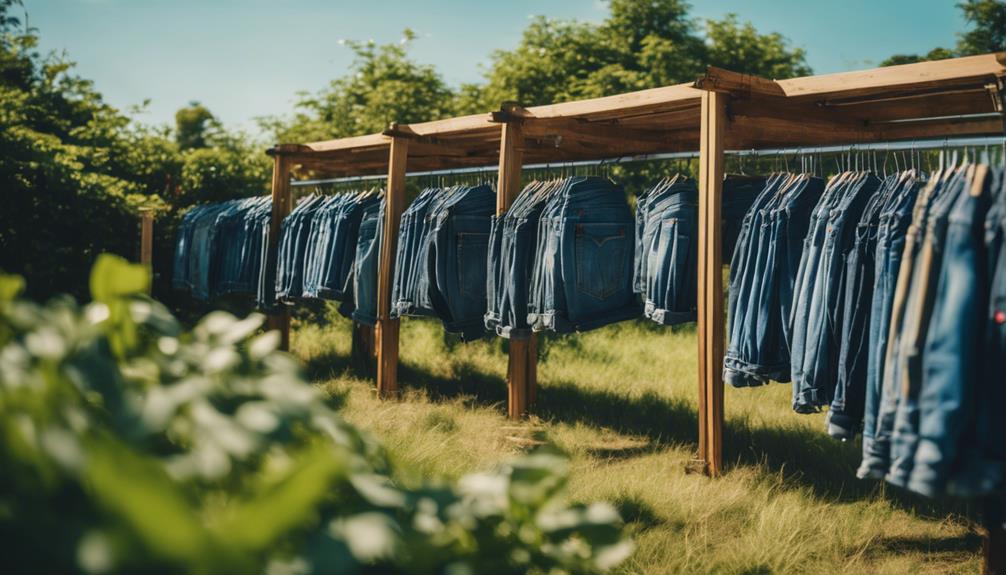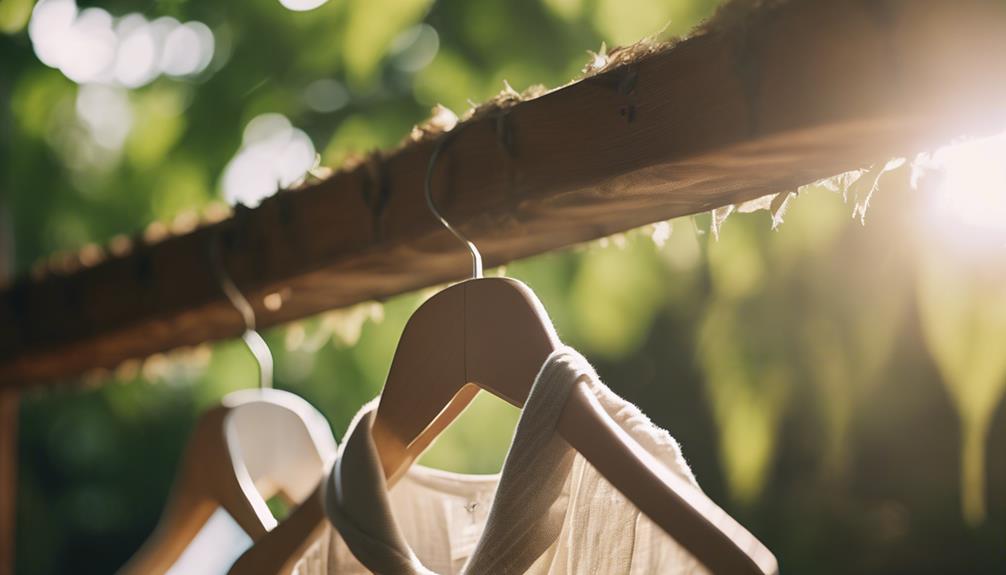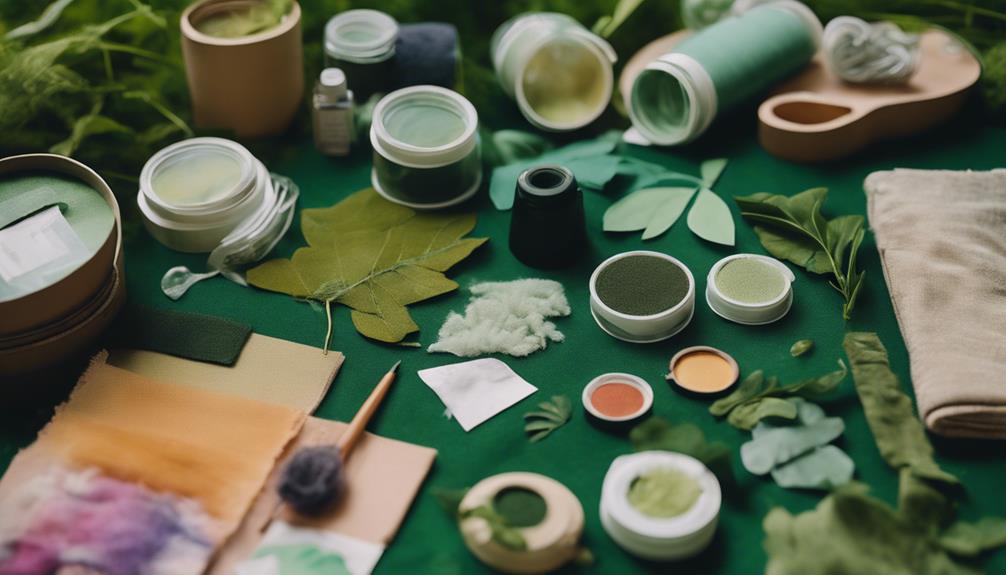When creating homemade beauty products, consider sustainable packaging to boost your brand and help the planet. Opt for materials like recyclable glass, biodegradable cornstarch, or reusable bamboo. These choices minimize waste and resonate with eco-conscious consumers. Refillable options are great too, encouraging customers to reuse containers and lower plastic waste. Lightweight, eco-friendly shipping materials can cut costs and reduce your carbon footprint. Partnering with sustainable suppliers can also enhance your commitment to a healthier environment. Explore various innovative solutions to craft responsible packaging that aligns with your values and captivates your audience. There's so much more to discover! By extending your eco-friendly ethos, you can also inspire customers to incorporate sustainability beyond beauty products, such as opting for sustainable home decor fabrics in their living spaces. This alignment of values not only strengthens your brand identity but also fosters a broader environmental impact. Together, these conscious choices create a ripple effect, promoting mindfulness and responsibility across various aspects of daily life.
Key Takeaways
- Choose recyclable, biodegradable, or reusable materials like bamboo, cornstarch, and glass to align with eco-friendly practices in packaging.
- Implement refillable packaging options to minimize plastic waste and encourage consumer loyalty through sustainable practices.
- Utilize minimalistic packaging designs to reduce material usage while enhancing brand visibility and the unboxing experience.
- Partner with sustainable suppliers for access to innovative eco-friendly materials, improving brand reputation and commitment to environmental stewardship.
- Explore the use of sustainable inks and labels, such as water-based or vegetable-based options, to further enhance the eco-friendliness of your products.
Importance of Sustainable Packaging
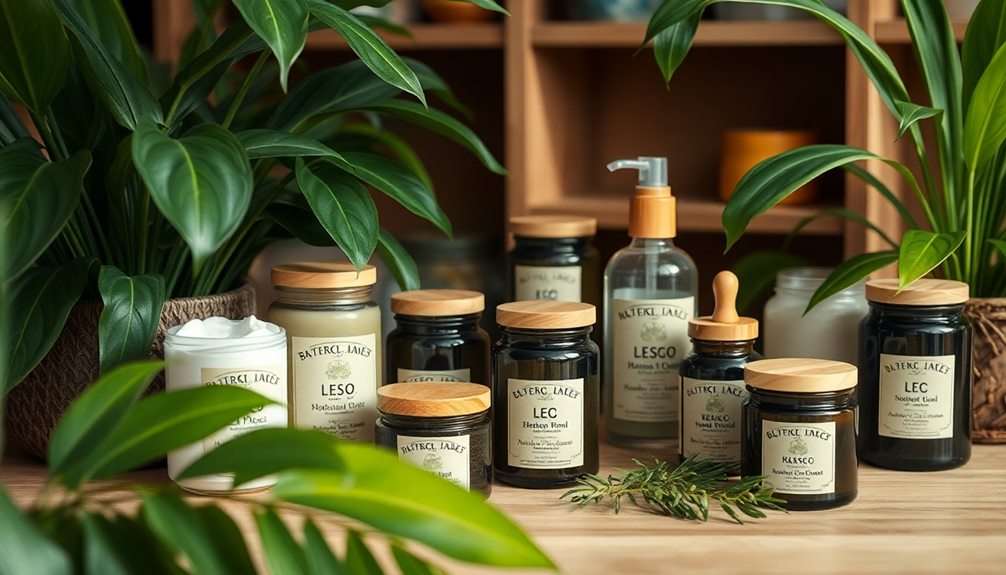
Sustainable packaging is essential in today's beauty industry, especially for homemade products. By choosing eco-friendly cosmetic packaging, you can greatly reduce the environmental impact while appealing to a growing base of eco-conscious consumers. This commitment to sustainability not only sets your brand apart but also fosters loyalty; in fact, 47% of consumers are willing to pay more for products that align with their environmental values.
Opting for sustainable packaging solutions, like biodegradable cosmetic containers and renewable materials, helps minimize waste in landfills. These packaging options also lower production costs, as you can reduce material usage and benefit from bulk purchasing.
Lightweight materials decrease shipping costs and lessen the carbon footprint associated with transportation, making your homemade beauty products even more eco-friendly.
Moreover, by adopting these practices, you enhance your brand's reputation and build trust among consumers, aligning your business with governmental initiatives promoting environmental responsibility.
As you implement sustainable packaging, you're not just making a choice for your products; you're making a positive impact on the planet and showing your customers that you care.
Defining Sustainable Packaging
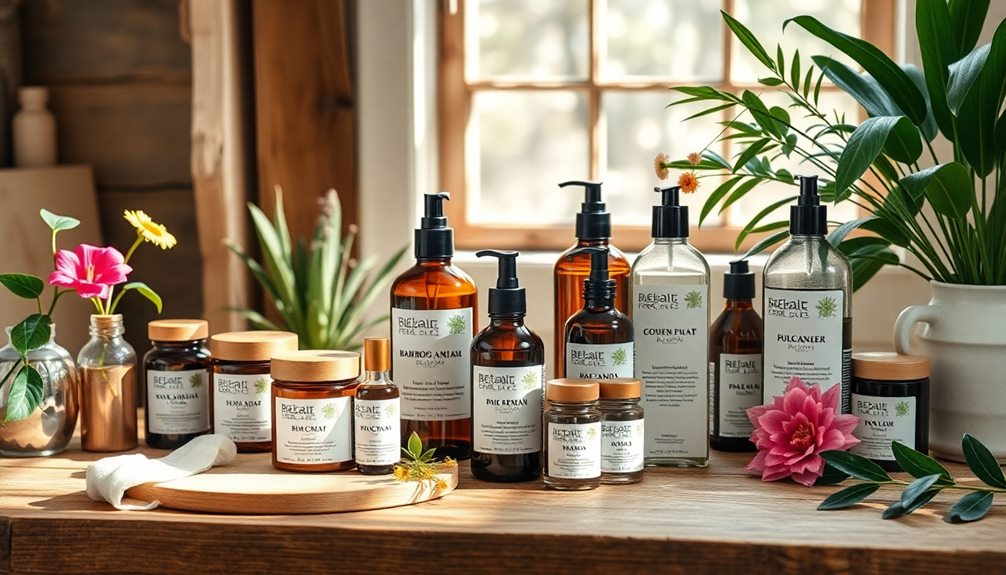
When you think about sustainable packaging, it's all about reducing environmental impact through smart material choices.
By selecting recyclable, biodegradable, or reusable materials, you considerably cut down on waste in the beauty industry.
Understanding the importance of these materials can help you make more eco-conscious decisions as a consumer.
Environmental Impact Reduction
Packaging plays an essential role in reducing environmental impact, and the shift towards sustainable options is becoming more evident in the beauty industry. By choosing sustainable packaging, you can greatly minimize packaging waste and promote the use of eco-friendly materials.
Opting for biodegradable and recyclable options not only helps you reduce your environmental footprint but also aligns with the growing consumer demand for responsible practices.
Here are some key benefits of sustainable packaging:
- Enhanced Brand Reputation: Implementing sustainable practices can boost your brand's image and build trust with your customers.
- Consumer Loyalty: Nearly half of consumers are willing to pay more for products featuring sustainable packaging, fostering loyalty among eco-conscious customers.
- Innovative Materials: Utilizing natural materials like cornstarch and seaweed can lower your carbon footprint and reduce reliance on traditional plastics.
As the market for post-consumer recycled (PCR) materials continues to grow, your commitment to sustainable packaging can set you apart.
Material Selection Importance
Choosing the right materials is key to defining what sustainable packaging truly means in the beauty industry. When you prioritize material selection, you're actively minimizing your environmental footprint.
Sustainable packaging options, like post-consumer recycled plastics, bamboo, and cornstarch, not only reduce waste but also help conserve natural resources. By opting for eco-friendly packaging, you align your brand with consumer demand for sustainability, enhancing loyalty and reputation.
Additionally, utilizing energy-efficient technology in the production process can further amplify your commitment to sustainability and reduce overall environmental impact.
Incorporating materials like glass and aluminum in your cosmetic containers provides a premium look while promoting a circular economy through recyclability. These choices support effective packaging strategies that reduce production costs, as fewer materials are needed and bulk purchasing becomes more feasible.
Plus, lightweight materials can lower shipping costs, further benefiting your bottom line.
Additionally, using biodegradable packaging guarantees that your products won't contribute to long-lasting waste in landfills. By focusing on sustainable packaging solutions, you're not just making a positive impact on the environment; you're also meeting the expectations of eco-conscious consumers.
Make material selection a priority in your beauty product line, and you'll see the rewards in both sustainability and customer satisfaction.
Types of Sustainable Materials
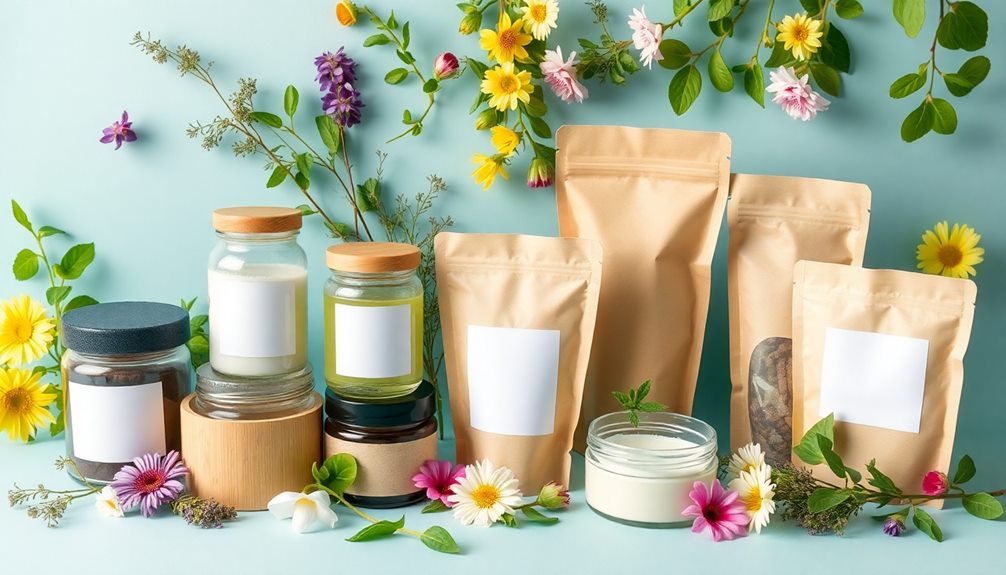
When it comes to sustainable materials for beauty packaging, you'll find plenty of biodegradable options that break down naturally, like cornstarch and seaweed.
Reusable solutions, such as bamboo and beeswax packaging, not only reduce waste but also add charm to your products.
Exploring these materials can help you make eco-friendly choices that resonate with today's conscious consumers.
Biodegradable Packaging Options
Embracing sustainability in beauty products begins with understanding the various biodegradable packaging options available today. Choosing biodegradable materials not only aligns with eco-friendly practices but also helps reduce reliance on traditional plastics.
Regular maintenance of your packaging can enhance its sustainability, much like how regular maintenance improves performance in vacuum cleaners. Here are some remarkable options for your homemade beauty products:
- Bamboo Packaging: This lightweight and durable option is sourced from renewable resources, making it a great plastic alternative.
- Cornstarch Packaging: Derived from renewable cornstarch, this organic material is perfect for lotions and other cosmetic applications, serving as a compostable choice.
- Seaweed Packaging: An innovative solution, seaweed packaging is versatile and contributes to marine sustainability, appealing to eco-conscious consumers.
Additionally, you might consider beeswax packaging, which acts as a moisture barrier for creams and balms while promoting sustainable beekeeping practices.
Post-consumer recycled (PCR) packaging is another excellent choice, utilizing materials like cardboard and plastic made from recycled resources to reduce carbon footprints.
Reusable Material Solutions
Utilizing reusable material solutions is a key strategy in reducing waste and fostering sustainability in the beauty industry. By opting for reusable packaging, like refillable glass containers, you greatly cut down on single-use plastic waste. This encourages you and other consumers to embrace sustainable practices while extending the lifecycle of your packaging.
Bamboo packaging is another great choice; it's biodegradable, lightweight, and made from renewable resources, offering an attractive alternative for various cosmetic products.
Similarly, cornstarch packaging, derived from renewable plant sugars, is biodegradable and aligns with the growing demand for eco-friendly materials.
When you choose glass packaging, you're opting for a fully recyclable solution that has a lower environmental impact compared to traditional plastics. It not only provides a premium look but also protects product integrity, promoting sustainability.
Don't overlook beeswax wraps, either. They serve as a natural, biodegradable alternative for cosmetic products, offering moisture barrier properties while supporting sustainable beekeeping practices that promote biodiversity.
Benefits of Refillable Packaging

Refillable packaging offers multiple advantages that greatly benefit both consumers and brands alike. By choosing refillable containers, you directly contribute to reducing plastic waste, as these encourage you to reuse rather than discard after a single use. This not only supports sustainability but also fosters a sense of responsibility towards the environment.
Here are some key benefits of refillable packaging:
- Customer Loyalty: Brands that promote refill programs often see increased loyalty, as you're more likely to return to businesses that align with your eco-friendly values.
- Cost Savings: Companies can lower production costs by using durable materials for refillable containers, which leads to less waste and reduced need for raw materials.
- Engagement Opportunities: Brands can create loyalty programs or discounts for refills, incentivizing you to participate in eco-friendly practices while boosting their sales.
Innovative Packaging Solutions
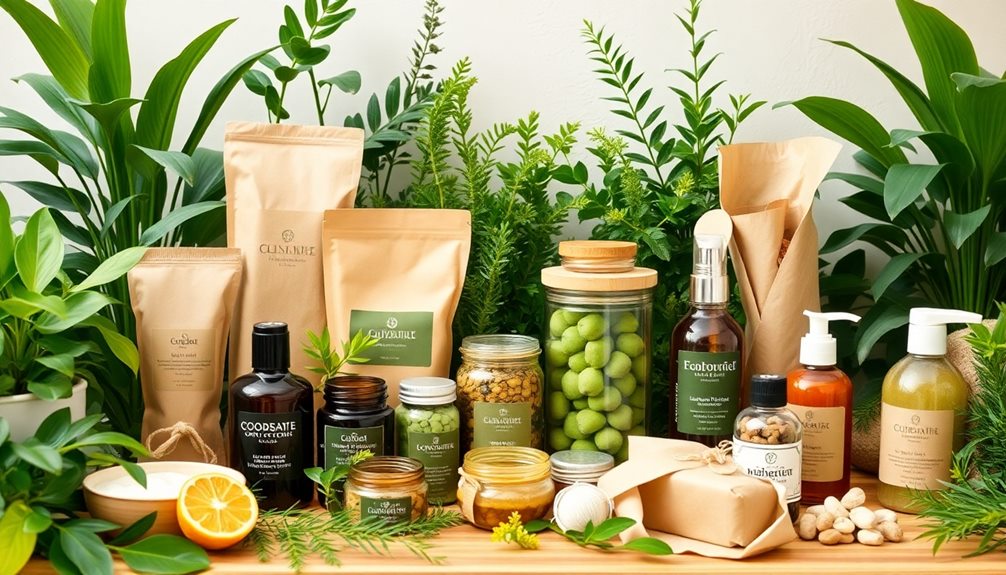
When you're looking for innovative packaging solutions, consider eco-friendly materials like cornstarch and seaweed that not only reduce waste but also appeal to environmentally conscious consumers.
Refillable designs can boost your brand's sustainability efforts while enticing customers to return for discounts.
Custom packaging can also enhance your product's appeal, using sustainable inks and labels to make a positive impact without sacrificing style.
Eco-Friendly Material Options
Choosing the right packaging for beauty products is essential for both aesthetics and sustainability. You want to guarantee that your packaging not only looks good but also aligns with eco-friendly materials that minimize environmental impact.
Here are some innovative options to reflect on:
- Bamboo Packaging: Lightweight, durable, and biodegradable, bamboo is a renewable resource that makes an ideal choice for your homemade beauty products.
- Cornstarch Packaging: This organic alternative to plastic is derived from renewable cornstarch and is fully biodegradable, helping reduce your carbon footprint.
- Glass Packaging: Offering a premium feel, glass is fully recyclable and chemically inert, making it perfect for creams and liquids without any chemical interactions.
You might also explore Beeswax Packaging, which serves as a natural moisture barrier for creams while supporting sustainable beekeeping practices.
Or reflect on Post-Consumer Recycled (PCR) Packaging, which uses recycled materials to lessen waste in our landfills.
Refillable and Custom Designs
There's a growing trend in the beauty industry toward innovative packaging solutions that not only prioritize sustainability but also enhance the overall consumer experience.
Refillable packaging is a game-changer, allowing you to reuse containers and greatly cut down on single-use plastic waste. By embracing this approach, you align your brand with eco-conscious values, appealing to consumers who care about the environment.
Custom packaging designs can further elevate your brand identity and boost consumer engagement. When you create unique and attractive packaging using biodegradable materials, you not only meet the demand for sustainability but also reduce the overall environmental impact of your products.
Plus, incorporating sustainable inks and labels shows your commitment to eco-friendly practices.
Innovative refill solutions, like offering discounted refills, can foster long-term customer loyalty. When consumers can easily replenish their favorite homemade beauty products, they're more likely to return for more.
Tailored packaging strategies not only enhance the aesthetic appeal but also communicate your brand's dedication to sustainability, ensuring you resonate with today's conscious consumers.
Strategies for Waste Minimization
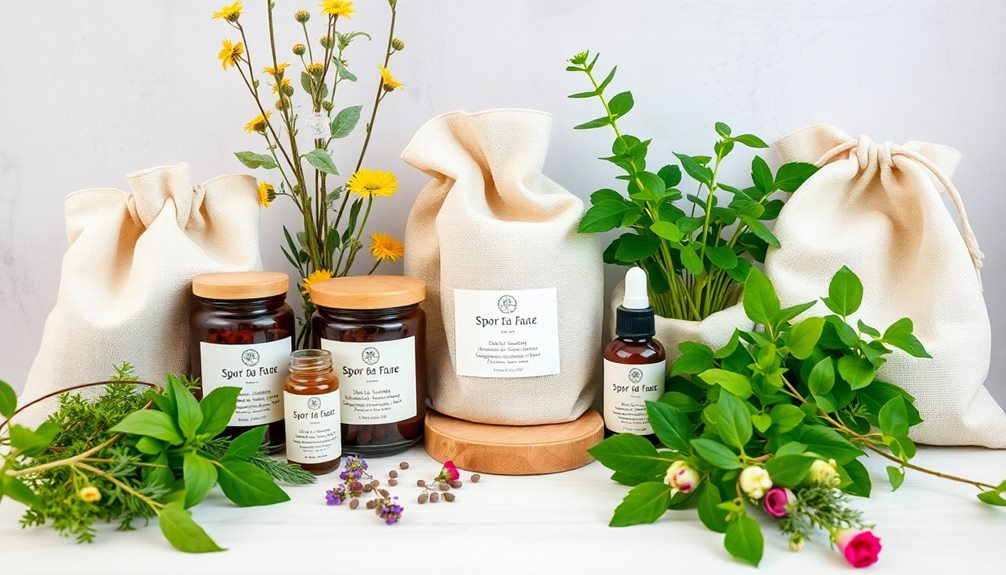
Sustainable practices in beauty packaging can considerably cut waste and benefit the environment. By focusing on strategies for waste minimization, you can contribute to a more sustainable cosmetic packaging framework. Here are some effective methods:
- Embrace minimalism in packaging: Streamlined designs reduce material usage and waste while still looking appealing. This approach aligns with content relevance and authority in SEO as it resonates with eco-conscious consumers.
- Opt for refillable containers: This encourages you and your customers to reuse packaging, greatly decreasing reliance on single-use plastics.
- Utilize biodegradable materials: Incorporating options like cornstarch or bamboo guarantees that your packaging decomposes naturally, aiding in waste reduction.
Additionally, encouraging participation in recycling programs can enhance recycling rates. Offering incentives for returning used containers makes it easier for everyone to dispose of them responsibly.
Finally, consider adopting eco-friendly shipping methods, like using paper tape and padded mailers made from recycled materials. These changes not only minimize packaging waste during delivery but also align with a commitment to sustainable practices.
E-commerce Packaging Considerations
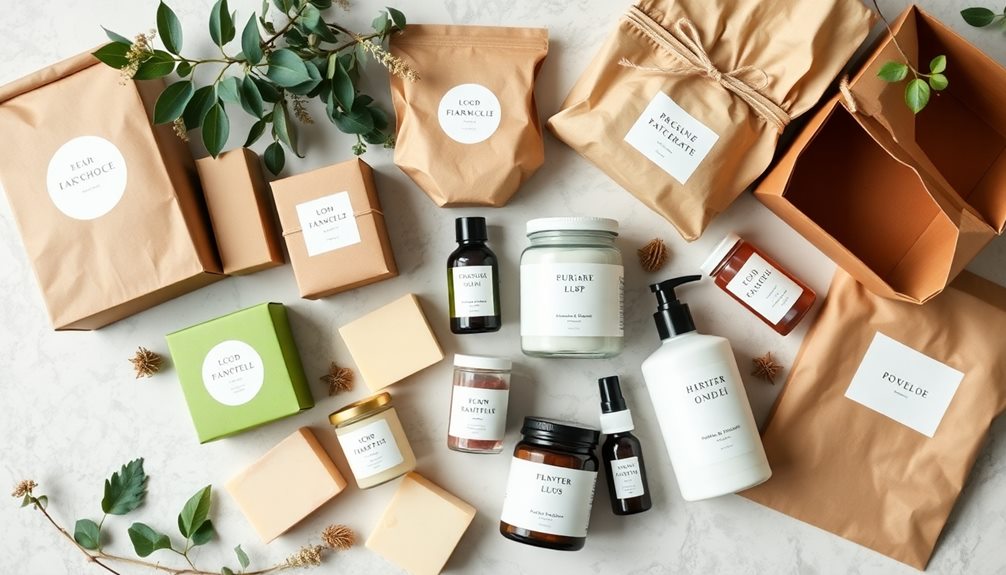
When selling homemade beauty products online, effective e-commerce packaging is essential for ensuring your products arrive safely to customers. Prioritizing protective materials helps reduce the risk of damage during transit, which can enhance customer satisfaction.
Opting for eco-friendly packaging options, like biodegradable fillers and recycled boxes, not only meets consumer preferences for sustainability but also showcases your commitment to environmentally responsible products.
Customization plays a significant role in improving brand visibility and creating a memorable unboxing experience. Unique designs and personalized touches can foster customer loyalty, making them more likely to return for future purchases.
Additionally, implementing efficient packaging designs can minimize shipping costs and waste, benefiting both your business and the environment by reducing carbon footprints.
Consider using sustainable materials, such as cornstarch or paper packaging, to appeal to eco-conscious consumers. These choices reflect your brand's values and align with the growing demand for environmentally responsible products.
Case Studies in Sustainability

As you explore the importance of sustainable packaging in the beauty industry, numerous brands demonstrate effective strategies that prioritize environmental responsibility.
These beauty brands are leading the way with innovative packaging designs that reduce waste and promote eco-friendliness.
- RMS Beauty uses recycled glass and metal packaging, along with soy-based inks, showcasing the effectiveness of sustainable materials in homemade beauty products.
- Kjaer Weis is renowned for its refillable packaging made from durable metal and glass, promoting a circular economy and reducing single-use plastic waste.
- Lush's Naked products feature compostable labels and minimal packaging, demonstrating how businesses can create a zero-waste approach in homemade cosmetics.
Additionally, Aveda employs plant-based inks in its packaging, providing eco-friendly printing solutions.
Sulapac stands out with a biodegradable alternative to conventional plastics, effectively reducing plastic waste while maintaining functionality and aesthetic appeal.
These case studies reveal how you can adopt sustainable practices in your own homemade beauty products, making a positive impact on the environment while appealing to eco-conscious consumers.
Embracing these alternatives to plastic not only enhances your brand's reputation but also supports a healthier planet.
Partnering With Sustainable Suppliers

Choosing to partner with sustainable suppliers can greatly enhance your beauty brand's commitment to eco-friendliness. By collaborating with these suppliers, you gain access to eco-friendly materials such as post-consumer recycled plastics, bamboo, and biodegradable options that resonate with consumer demand for greener beauty products.
Sustainable suppliers often specialize in innovative sustainable packaging solutions, providing insights into materials like Sulapac, which serves as a biodegradable alternative to conventional plastics. This not only boosts your product appeal but also reinforces your environmental responsibility.
Additionally, partnering with suppliers knowledgeable in renewable materials can streamline the integration of sustainable practices within your homemade beauty product line. This collaboration improves overall efficiency and helps you achieve specific sustainability goals, such as offering refillable or minimalist designs that greatly reduce waste.
Moreover, engaging with eco-conscious companies enhances your brand reputation. As 47% of consumers are willing to pay more for sustainable options, investing in these partnerships can lead to a loyal customer base committed to supporting your eco-friendly initiatives.
Embracing sustainable suppliers is essential for any beauty brand aiming for a greener future.
Trends in Eco-Friendly Packaging
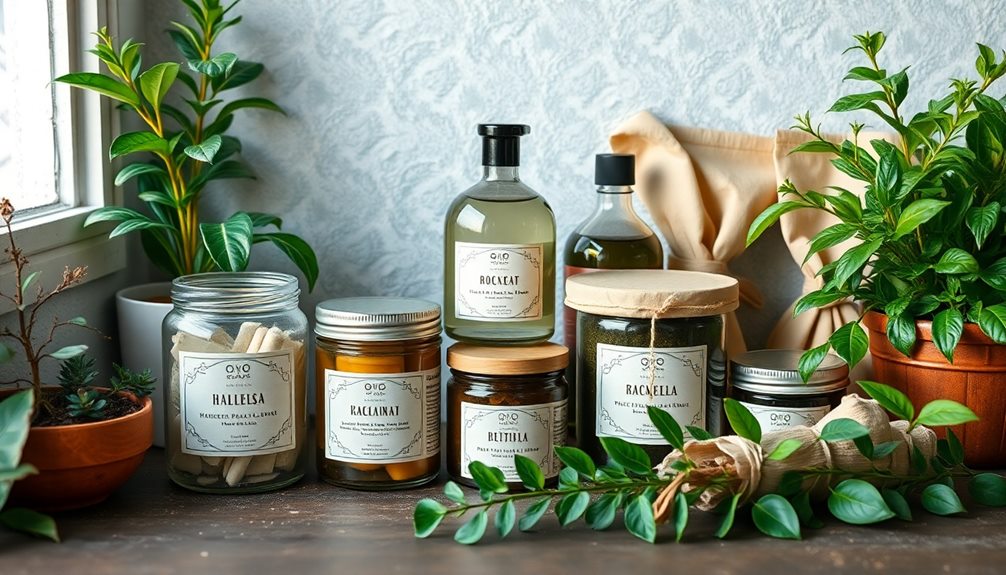
Embracing innovative solutions, beauty brands are increasingly adopting eco-friendly packaging trends that resonate with consumers.
The shift toward sustainable packaging is evident, with the global market projected to grow considerably, reflecting rising consumer demand for environmentally friendly options.
In fact, 74% of you're willing to pay more for products that come in eco-friendly materials.
Here are some key trends in eco-friendly packaging:
- Biodegradable Materials: Cosmetic brands are now using innovative materials like cornstarch and seaweed, which break down naturally and reduce environmental impact.
- Refillable Packaging: More brands are encouraging you to reuse containers, minimizing single-use plastic waste while promoting sustainability.
- Sustainable Inks and Labels: The use of water-based and vegetable-based inks is on the rise, enhancing the appeal of products while aligning with eco-conscious values.
Frequently Asked Questions
What Is the Most Eco-Friendly Packaging for Cosmetics?
The most eco-friendly packaging for cosmetics includes biodegradable materials, refillable systems, and recyclable options like glass or aluminum. These choices reduce waste and promote sustainability, making your beauty routine both responsible and stylish.
What Are the Sustainable Packaging Materials for Skincare?
You might think sustainable packaging is too expensive, but options like post-consumer recycled materials, bamboo, cornstarch, glass, and beeswax offer eco-friendly choices that enhance your skincare products while protecting the planet. Choose wisely!
How Can We Make Packaging That Is More Environmentally Friendly for Our Products?
You can make packaging more environmentally friendly by using biodegradable materials, opting for refillable options, incorporating recycled materials, and adopting minimalist designs. Every small change helps reduce waste and promotes sustainability in your product line.
How Can We Make Eco-Friendly Beauty Products?
You might wonder how to create eco-friendly beauty products. Start with organic ingredients and natural preservatives, then choose minimalist designs. Educate others about sustainability, and together, you'll inspire a greener beauty routine that truly makes a difference.
Conclusion
In the world of homemade beauty products, embracing sustainable packaging isn't just a trend; it's a movement that nurtures our planet. By choosing eco-friendly materials and innovative solutions, you're not only enhancing your brand but also playing a crucial role in reducing waste. Think of your packaging as a gift to nature, wrapping your creations in care. So, let's join hands and make a positive impact, one beautiful product at a time!



